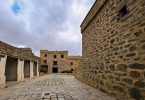SRI LANKA (eTN) – Recently, I spent some time in the cultural triangle area, after quite a long lay-off of about 7-9 months. Having now moved away from mainstream, hands-on tourism for a while, it was nice to go back to familiar haunts. I was in the region to conduct an awareness seminar on improving sustainable environmental and energy management practices in hotels, under the auspices of the SWITCH Asia Greening hotels initiative, administered by the Ceylon Chamber of Commerce, where I now consult.
While my team prepared for the seminar at Hotel Sigiriya, I could not resist taking some time off to visit the Minneriya National Park to check out the “Gathering.” The “Gathering” is one of the most unique wildlife spectacles in Asia, where during the months of May to September, large numbers of wild elephants – 150 or more – gather around the banks of the Minneriya reservoir or tank. Viewing these elephants is quite easy, and today, due to the efforts of some of us wildlife enthusiasts,and with the support of Sri Lanka tourism, this is now fast becoming a “branded” event referred to as “The Gathering.”
There had been some discussions as to whether The Gathering would take place this year, due to the radically changing weather patterns experienced, where the park had severe rain as late as in April and May. There was also a school of thought that maybe the elephants would migrate further northwards this year, with the conflict situation being now nonexistent, allowing much easier freedom of movement.
So there I was, on a somewhat overcast Monday afternoon, setting off with my regular jeep driver Denzil to Minneriya Park to check out The Gathering, first hand. We drove slowly along the bone-rattling 13 km stretch of the Sigiriya – Moragaswawe short cut and joined the superbly-surfaced A 11 highway leading to Batticaloa. Denzil’s World War II vintage jeep picked up speed, and within 15 minutes we were at the park entrance. The increasing influx of tourists could also be seen here, with over ten jeep loads waiting to enter the park. I noted that only two were with Sri Lankans, while all the others were foreigners. (Sri Lanka tourism has grown some 50 percent during the last 6 months.). While all the jeeps were filled to the brim, (some actually overflowing with passengers) our jeep was the center of attraction with only me and the driver.
We realized that the trackers were none too keen to accompany just me alone into the park, what with so many tourists around and the possibility of US $ tips in the offing. Seeing the familiar faces of Denzil and me, the deputy warden sheepishly asked us whether we could “track” ourselves and manage on our own inside the park. Nothing would have suited me better, and Denzil and I sped off, much to the astonishment of the waiting visitors.
We drove along the graveled main road of the park, noticing that the park was quite dry, as is the case during this time of the year. The fast-growing wild bamboo bushes were veritable trees with their shoots rising up some 6-8 meters into the sky. Checking with a prematurely departing set of visitors, we heard that the elephants were on the right side of the “wew pitiya” (open plains). This is the western side of the park, which is bifurcated from the rest of the park by an “ara” or stream. During the rainy season, negotiating this stream was a challenge, but now it had only a small extent of water flowing, making the crossing much easier.
Just as we clambered onto the opposite bank, we came across our first lot of elephants, peacefully grazing just by the side of the road. There were some 30 or more elephants, and I was particularly happy to see a 4- to 5-year-old budding tusker among them. A relatively less number of Sri Lankan male elephants have tusks, and with the overall dwindling population, it was good to see the tusker gene still proliferating, albeit in small numbers. There are a few sightings of tuskers in the central province, the most unique being “one tusk John,” a majestic male elephant, in prime condition and having only one tusk. In fact, I was rather anxious about his whereabouts, since there had been no reported sightings of him that I had come to know about for some time. However, Denzil reassured me that he was very much in the area and that he had seen him in the park a few days ago.
In the far distance, there were many more elephants, and as we drove closer, I realized that the numbers were very much larger than I had earlier thought. I stopped counting after 220 or so and decided to enjoy the wonderful sightings that we were having. The elephants seemed to be well fed and relaxed. Although there were juveniles, it seemed to me that their numbers were not so great. I counted not more than 8 juveniles, which, amongst a gathering of 200+ appeared to be less than normal for Minneriya. Usually almost every other mature female seems to have a juvenile in attendance. It may be that calving cycle was still to begin, which was perhaps borne out by the fact that there were only three mature males loitering around. I have seen on occasions over 8-10 males jostling and competing to court a receptive female. The three who were there were nonchalantly grazing on their own, away from the rest.
I sighted another adolescent tusker in the making, not to be mistaken with the young tusker seen regularly in the park, who has a tennis ball like growth on the side of his jaw. This augured well… two new “up and coming” tuskers. I then noticed a mature female with a radio collar, something I had not seen before. Denzil told me that the collar had been there for sometime on this elephant, but could not shed any more information regarding who was studying the movements of this elephant. Very little study has been conducted on the Minneriya Gathering, and no one really can be certain where these elephants all disperse to, come November/December/January.
Various theories have been mooted that they migrate far and wide to all parts of the central province, ranging to the Wasgamuwa National Park, Kaudulla, Hurulu wewe, Maduru Oya National Park, Somawathi Chaitiya Sanctuary, Kekirawa, Kala wewe, and even Gal Oya and Kantalai.
So the fact that some scientific study was underway excited me. Subsequently when I got back to the hotel, I checked around with the “elephant fraternity” and learned that it was Dr. Prithiviraj Fernando who was carrying out this work. He was using a GPS collar so that he could track the movements from a remote location. The cheaper radio collar requires on-site physical presence to track the elephant’s location, by hand-held antenna for triangulation. The more sophisticated GPS systems, automatically uploads the position of the collared elephant to a satellite, which can be downloaded in real time onto a computer at a remote location. In fact, Dr. Prithiviraj told me that there were four elephants with collars, and most interestingly, the initial findings were that the elephants do not move too far away from Minneriya and tend to habitate the Hululu wewe area predominantly. Obviously more prolonged observation and study has to be done, to really solve the riddle of how some 200+ elephants simply vanish almost overnight come the rains in October.
As I soaked up this wonderful and awesome spectacle, I could not help but realize what a really beautiful environment we have. Where on Earth could you drive 25 minutes from a star-class tourist hotel and be surrounded by hoards of wild elephants peacefully grazing around you? In spite of having seen the gathering so many time, and being the co-originator (along with Gehan de Silva Wijeratne) of the branding of this spectacle for Sri Lanka tourism as “The Gathering,” I was so thrilled once again to see and experience this truly unique phenomenon.
I was quite convinced that this was one of the largest sightings I have seen in one particular area. I had seen large numbers of elephants before, but they had been dispersed in different areas. Later on in the evening, I learned that there had been a large forest fire in the Hurulu wewe/eco park area on the Trinco road a week back, which had raged for several days, destroying large tracts of forests and was finally brought under control by the intervention of the air force utilizing helicopters. So there was a postulation that perhaps a larger number of elephants had moved into the Minneriya park because of the fire.
Thankfully, the jeep drivers were very well behaved with hardly anyone going “off road” and disrupting the elephants. As if on cue, one matriarch stopped grazing, walked purposefully on to the road, and stood there. Immediately, many of the other elephants responded to her inaudible “call” (elephants communicate in infra-sound, frequencies well below the hearing threshold of humans) and started moving “en masse” to the water.
I tried to identify whether the call seemed to be relayed by other females, but everyone seemed to have responded to this one matriarch’s instructions.
Now, elephant herds usually number around 15-20 and is led by a matriarch. But when several herds get together, like at Minneriya, there seems to be some form of shared responsibility among the matriarchs. According to research carried out on large African elephant groupings by Cynthia Moss, there are several levels of organizational hierarchy in such large gatherings. Within respective herds there could be some relatively consistent associations over time and such family groups are termed “kin groups.” There could be certain biological relationships between members of kin groups. These studies have also revealed that in large African herds there is a third level of organizational structure. A number of family units, bond or kin groups, and other unrelated families, will usually share a common area of good feeding habitat. Such larger groupings are known as “clans.” The African experience suggests that such large gatherings provide a focal point for mating activities, concentrating the sexually active bulls together with receptive females, rather than them having to search over large areas to find females. It is obvious, therefore, that much more exciting work that needs to be done with the herds in Minneriya and their social hierarchy.
The herds were by this time watering some distance away from the road, but still provided some fascinating viewing. Some quietly stood at the edge of the water, drinking peacefully, others were more playful, fully immersing themselves in the water and rolling over. Yet a few others preferred to rub themselves on the mud banks.
As the evening sun began its slow decent, reluctantly I asked Denzil to turn the jeep around and head back. We drove back to the hotel, in silence, marveling at the simply fantastic spectacle that we had just witnessed.
(eTN): Revisiting “The Gathering” of elephants at Minneriya National Park | re-post license | post content






















